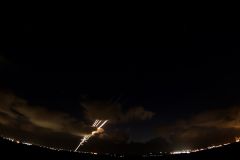Share
Human Rights Voices
While the UN devotes its human rights operations to the demonization of the democratic state of Israel above all others and condemns the United States more often than the vast majority of non-democracies around the world, the voices of real victims around the world must be heard.
Palestinian Authority/Gaza, December 1, 2019
Israel struck by over 2,600 rockets and mortars over past two years
Original source
Over 1,500 rockets and mortars have been fired towards Israel over the past year from the Hamas-run Gaza Strip and over two dozen fired from Syria, a significant increase in the past four years.
According to numbers released by the Shin Bet (Israel Security Agency), more than 2,600 rockets and mortars have been fired over the past two years from Gaza. Over half were in the last year alone.
The majority of the rockets and mortars fired into southern Israel over the past year occurred during three violent rounds of conflict with the blockaded coastal enclave.
In late November 2018 over 500 rockets and mortars were fired towards southern Israel in the span of 48 hours, including a Kornet anti-tank missile towards an empty IDF bus after a botched IDF commando raid in the southern Gaza city of Khan Yunis.
In May 2019, Hamas and Palestinian Islamic Jihad (PIJ) launched 690 rockets and mortars towards Israel, again over the span of less than 48 hours. While the large majority of the projectiles landed in open territory, 240 were intercepted by the Iron Dome missile defense system and another 21 hit residential homes. One Kornet anti-tank missile was fired towards a civilian car, killing the driver.
Following the targeted assassination of PIJ commander Bahaa abu al-Ata in November, the group fired over 400 rockets and mortars towards southern and central Israel in less than 50 hours.
In March 2019 militants fired over 60 rockets into southern Israel after Israel retaliated for a long-range missile strike from Gaza which destroyed a civilian home some 120 km. away in the central Israeli community of Mishmeret, injuring seven members of one family and a neighbor.
In response to the rocket fire from Gaza, the IDF has struck close to 1,000 targets in the Strip over the past year, the large majority of them belonging to Hamas.
While almost every year since Hamas took control of the Gaza Strip in 2007 the number of rockets fired toward Israel was in triple digits, 2018 has seen the most serious peak of violence between Israel and terror groups in the Strip like Hamas and PIJ since the end of Operation Protective Edge in 2014.
In comparison, a total of just over 1,000 projectiles were fired towards Israel in 2018 and 35 projectiles were fired towards Israel in 2017 and 15 the previous year and 21 in 2015 for a total of 71 rockets launched from the coastal enclave by terror groups.
In 2007 Israel was hit by 2,433 projectiles and in 2008 during Operation Cast Lead terror groups fired 3,557 projectiles. In 2012 during Operation Pillar of Defense Israel was struck by 2,771 rockets and in 2014, which coincided with Operation Protective Edge, Israel was bombarded by 4,897 projectiles.
Israel has also suffered from rocket fire on its northern front.
While many projectiles that struck northern Israel during the height of Syrian military campaigns against rebel groups were stray, in the past two years dozens of rockets have fired by Iran or Iranian-backed Shi'ite militia groups in Syria. Most recently four rockets were fired towards Israel's Golan Heights, leading to a widespread IAF retaliation against Iranian targets in the war-torn country.
On August 1, on the first day back to school in Israel, Hezbollah fired a Kornet anti-tank missile towards an IDF vehicle in northern Israel driving between the communities of Yir'on and Avivim.
While there were no Israeli casualties or injuries, the incident marked the first time since the Second Lebanon War in 2006 that saw direct confrontation between the IDF and Hezbollah which could have spiraled into war.
In May of last year the IDF carried out the most extensive operation in Syria since 1974 – striking over 50 Iranian targets in Syria in an operation called "House of Cards" following a missile barrage of 32 Fajr-5 and Grad missiles towards Israel's front defensive line in the Golan Heights.

